Resilience of Smart Cities to the Consequences of the COVID-19 Pandemic in the Context of Sustainable Development
Abstract
1. Introduction
2. Materials and Methods
2.1. Bibliometric Analysis
2.2. Databases and Index Calculation
- The purpose of the Smart City Index is to evaluate and rank cities based on the assessment of structures and technology applications available to the city residents in different areas, unlike other indices, in which the priority is sustainability, prosperity, governance, etc.
- The Index is calculated annually; the 2021-report is based on the data of 2019–2021 (survey results for these years are used in the calculation of the final score with the weight of 3:2:1 for 2021:2020:2019), corresponding to the period selected in the study of the smart cities’ resilience to COVID-19;
- The Smart City Index provides a comprehensive assessment of cities, including various aspects of their functioning, such as health and safety, mobility, activities, opportunities and governance. It is important to have scores for the health and safety component, allowing a detailed analysis to be carried out in this direction in terms of COVID-19;
- Publicly available data for all cities regarding Smart City Rank indicators and their scores by specific areas;
- The report on the Smart City Index 2021 includes 118 cities, which ensures the sufficiency of the sample for the analysis.
2.3. Cluster Analysis
2.4. Correlation Analysis
3. Results
3.1. Bibliometric Analysis Results
- (1)
- Smart city and sustainable development (red cluster);
- (2)
- Decision making (green cluster);
- (3)
- COVID-19 (blue cluster);
- (4)
- Machine learning (yellow cluster);
- (5)
- Internet of things (violet cluster).
3.2. COVID-19 Severity on City/Country Levels
3.3. Cluster Analysis Results
- The countries were fairly evenly distributed among the clusters: there is the largest cluster, which includes 15 countries, the number of countries in the other clusters is 10, 11 and 12;
- According to the plot of means, Spread Response is the main variable for clustering the countries. The cluster 1 was formed by the largest values of this variable;
- Cluster analysis confirmed the importance of the geographical factor. Except for the cluster 1, a clear geographical division can be seen in the distribution of cities by other clusters. All North American cities (except Vancouver, which is in cluster 1) formed the third cluster; all South American cities are included in the second cluster, most European cities are in the 4th cluster;
- The relationship between the distribution of cities and their Smart City Rank (SCR) can be traced in clusters 2 and 3: cities in cluster 2 have lower-than-average SCR (min 91, max 118), and in cluster 3, average and higher-than-average SCR (min 12, max 85). Clusters 1 and 4 formed of cities with a large difference in SCR: cluster 1—min 33, max 115; cluster 4—min 1, max 112. However, in cluster 1, most cities have lower-than-average SCR, and in cluster 4, two thirds of cities are cities with higher-than-average SCR.
3.4. Correlation Analysis Results
4. Discussion
5. Conclusions
Author Contributions
Funding
Institutional Review Board Statement
Informed Consent Statement
Data Availability Statement
Conflicts of Interest
References
- Yarovenko, H.; Kuzmenko, O.; Stumpo, M. DEA-Analysis of the Effectiveness of the Country’s Information Security System. SocioEcon. Chall. 2020, 4, 142–153. [Google Scholar] [CrossRef]
- Kuzmenko, O.; Cyburt, A.; Yarovenko, H.; Yersh, V.; Humenna, Y. Modeling of “information bubble” in the global information space. J. Int. Stud. 2021, 14, 270–285. [Google Scholar] [CrossRef]
- Polyakov, M.; Bilozubenko, V.; Korneyev, M.; Shevchenko, G. Selection of parameters for multifactor model in the knowledge economy marketing (country level). Innov. Mark. 2019, 15, 89–99. [Google Scholar] [CrossRef]
- Khanin, I.; Shevchenko, G.; Bilozubenko, V.; Korneyev, M. A cognitive model for managing the national innovation system parameters based on international comparisons (the case of the EU countries). Probl. Perspect. Manag. 2019, 17, 153–162. [Google Scholar] [CrossRef]
- Yarovenko, H.; Bilan, Y.; Lyeonov, S.; Mentel, G. Methodology for assessing the risk associated with information and knowledge loss management. J. Bus. Econ. Manag. 2021, 22, 369–387. [Google Scholar] [CrossRef]
- Mańka-Szulik, M.; Krawczyk, D. Optimizing the Provision of Public Services by Local Administration as a Component of the Smart City Concept on the Example of Zabrze. Manag. Syst. Prod. Eng. 2022, 30, 192–199. [Google Scholar] [CrossRef]
- Kinelski, G.; Stechły, J.; Bartkowiak, P. Various Facets of Sustainable Smart City Management: Selected Examples from Polish Metropolitan Areas. Energies 2022, 15, 2980. [Google Scholar] [CrossRef]
- Fila, M.; Levicky, M.; Mura, L.; Maros, M.; Korenkova, M. Innovations for business management: Motivation and barriers. Mark. Manag. Innov. 2020, 4, 266–278. [Google Scholar] [CrossRef]
- Wang, Q.; Chen, Y.; Guan, H.; Lyulyov, O.; Pimonenko, T. Technological innovation efficiency in China: Dynamic evaluation and driving factors. Sustainability 2022, 14, 8321. [Google Scholar] [CrossRef]
- Melnyk, L.; Matsenko, O.; Kubatko, O.; Korneyev, M.; Tulyakov, O. Additive economy and new horizons of innovative business development. Probl. Perspect. Manag. 2022, 20, 175–185. [Google Scholar] [CrossRef]
- Kuzior, A.; Mańka-Szulik, M.; Krawczyk, D. Changes in the management of electronic public services in the metropolis during the covid-19 pandemic. Pol. J. Manag. Stud. 2021, 24, 261–275. [Google Scholar] [CrossRef]
- Kuzior, A.; Kettler, K.; Rąb, Ł. Digitalization of Work and Human Resources Processes as a Way to Create a Sustainable and Ethical Organization. Energies 2022, 15, 172. [Google Scholar] [CrossRef]
- Tiutiunyk, I.; Drabek, J.; Antoniuk, N.; Navickas, V.; Rubanov, P. The impact of digital transformation on macroeconomic stability: Evidence from EU countries. J. Int. Stud. 2021, 14, 220–234. [Google Scholar] [CrossRef]
- El Amri, A.; Boutti, R.; Rodhain, F. Sustainable Finance at the time of Institutions: Performativity through the lens of Responsible Management in Morocco. Financ. Mark. Inst. Risks 2020, 4, 52–64. [Google Scholar] [CrossRef]
- Lyulyov, O.; Chygryn, O.; Pimonenko, T. National brand as a marketing determinant of macroeconomic stability. Mark. Manag. Innov. 2018, 3, 142–152. [Google Scholar] [CrossRef]
- Weder, F.; Mertl, S.; Hübner, R.; Elmenreich, W.; Sposato, R. Re-Framing Sustainability in a Pandemic. Understanding Sustainability Attitudes, Behaviors, Visions and Responsibilities for a Post-Covid Future. J. Sustain. Res. 2022, 4, e220006. [Google Scholar] [CrossRef]
- Karaoulanis, A. Big Data, What Is It, Its Limits and Implications in Contemporary Life. Bus. Ethics Leadersh. 2018, 2, 108–114. [Google Scholar] [CrossRef]
- Beyi, W.A. The Trilogy of a Digital Communication between the Real Man, His Digital Individual and the Market of the Digital Economy. SocioEcon. Chall. 2018, 2, 66–74. [Google Scholar] [CrossRef]
- Miskiewicz, R. Internet of things in marketing: Bibliometric analysis. Mark. Manag. Innov. 2020, 3, 371–381. [Google Scholar] [CrossRef]
- Kuzior, A.; Kwilinski, A. Cognitive Technologies and Artificial Intelligence in Social Perception. Manag. Syst. Prod. Eng. 2022, 30, 109–115. [Google Scholar] [CrossRef]
- Chen, X.; Wu, S.; Shi, C.; Huang, Y.; Yang, Y.; Ke, R.; Zhao, J. Sensing Data Supported Traffic Flow Prediction via Denoising Schemes and ANN: A Comparison. IEEE Sens. J. 2020, 20, 14317–14328. [Google Scholar] [CrossRef]
- Degas, A.; Islam, M.R.; Hurter, C.; Barua, S.; Rahman, H.; Poudel, M.; Ruscio, D.; Ahmed, M.U.; Begum, S.; Rahman, M.A.; et al. A Survey on Artificial Intelligence (AI) and eXplainable AI in Air Traffic Management: Current Trends and Development with Future Research Trajectory. Appl. Sci. 2022, 12, 1295. [Google Scholar] [CrossRef]
- Kwilinski, A.; Tkachenko, V.; Kuzior, A. Transparent cognitive technologies to ensure sustainable society development. J. Secur. Sustain. Issues 2019, 9, 561–570. [Google Scholar] [CrossRef]
- Billedeau, D.B.; Wilson, J.; Samuel, N. From Responsibility to Requirement: COVID, Cars, and the Future of Corporate Social Responsibility in Canada. Sustainability 2022, 14, 6658. [Google Scholar] [CrossRef]
- OECD Policy Responses to Coronavirus (COVID-19). Available online: https://www.oecd.org/coronavirus/policy-responses/cities-policy-responses-fd1053ff/ (accessed on 1 August 2022).
- Smiianov, V.A.; Lyulyov, O.V.; Pimonenko, T.V.; Andrushchenko, T.A.; Sova, S.; Grechkovskaya, N.V. The impact of the pandemic lockdown on air pollution, health and economic growth: System dynamics analysis. Wiad. Lek. 2020, 73, 2332–2338. Available online: https://wiadlek.pl/wp-content/uploads/archive/2020/WLek202011102.pdf (accessed on 1 August 2022). [CrossRef]
- Hasan, F.; Islam, M.R.; Ishrat, F. COVID-19 Pandemic Impact on the Supply Chains of UK-Based Multinational Manufacturing Companies. Bus. Ethics Leadersh. 2022, 6, 44–67. [Google Scholar] [CrossRef]
- Vasilyeva, T.; Ziółko, A.; Kuzmenko, O.; Kapinos, A.; Humenna, Y. Impact of digitalization and the Covid-19 pandemic on the aml scenario: Data mining analysis for good governance. Econ. Sociol. 2021, 14, 326–354. [Google Scholar] [CrossRef]
- Tommaso, F.D. The New Italian Legislation on Corporate Governance and Business Crisis. The Impact of COVID-19 on SMEs and the Recent Rules to Mitigate the Effects. Financ. Mark. Inst. Risks 2020, 4, 91–108. [Google Scholar] [CrossRef]
- Zhang, L.; Chen, Y.; Lyulyov, O.; Pimonenko, T. Forecasting the effect of migrants’ remittances on household expenditure: COVID-19 impact. Sustainability 2022, 14, 4361. [Google Scholar] [CrossRef]
- Keliuotytė-Staniulėnienė, G.; Daunaravičiūtė, K. The Global Green Bond Market in the Face of the COVID-19 Pandemic. Financ. Mark. Inst. Risks 2021, 5, 50–60. [Google Scholar] [CrossRef]
- Tovmasyan, G.; Minasyan, D. The Impact of Motivation on Work Efficiency for Both Employers and Employees also during COVID-19 Pandemic: Case Study from Armenia. Bus. Ethics Leadersh. 2020, 4, 25–35. [Google Scholar] [CrossRef]
- Dutta, P.; Dutta, U.; Hasan, S.; Sarkar, S.; Sana, T. Educate, Empower and Protect People Through Timely Authentic Information: Explore How Bangladeshi Newspapers Response To COVID-19 Pandemic. SocioEcon. Chall. 2020, 4, 93–103. [Google Scholar] [CrossRef]
- Makarenko, I.; Plastun, A.; Petrushenko, Y.; Vorontsova, A.; Alwasiak, S. SDG 4 and SDG 8 in the knowledge economy: A meta-analysis in the context of post-COVID-19 recovery. Knowl. Perform. Manag. 2021, 5, 50–67. [Google Scholar] [CrossRef]
- Kuzmenko, O.V.; Smiianov, V.A.; Rudenko, L.A.; Kashcha, M.O.; Vasilyeva, T.A.; Kolomiiets, S.V.; Antoniuk, N.A. Impact of vaccination on the Covid-19 pandemic: Bibliometric analysis and cross country forecasting by Fourier series. Wiad. Lek. 2021, 74, 2359–2367. [Google Scholar] [CrossRef] [PubMed]
- Abdullah, M.; Ali, N.; Dias, C.; Campisi, T.; Javid, M.A. Exploring the Traveler’s Intentions to Use Public Transport during the COVID-19 Pandemic While Complying with Precautionary Measures. Appl. Sci. 2021, 11, 3630. [Google Scholar] [CrossRef]
- Javid, M.A.; Abdullah, M.; Ali, N.; Dias, C. Structural equation modeling of public transport use with COVID-19 precautions: An extension of the norm activation model. Transp. Res. Interdiscip. Perspect. 2021, 12, 100474. [Google Scholar] [CrossRef]
- Gkiotsalitis, K.; Cats, O. Public transport planning adaption under the COVID-19 pandemic crisis: Literature review of research needs and directions. Transp. Rev. 2021, 41, 374–392. [Google Scholar] [CrossRef]
- Shen, J.; Duan, H.; Zhang, B.; Wang, J.; Ji, J.; Wang, J.; Pan, L.; Wang, X.; Zhao, K.; Ying, B.; et al. Prevention and control of COVID-19 in public transportation: Experience from China. Environ. Pollut. 2020, 266, 115291. [Google Scholar] [CrossRef]
- Lashgari, Y.S.; Shahab, S. The Impact of the COVID-19 Pandemic on Retail in City Centres. Sustainability 2022, 14, 11463. [Google Scholar] [CrossRef]
- Gade, D.S.; Aithal, P.S. Smart Cities Development During and Post COVID-19 Pandemic—A Predictive Analysis. Int. J. Manag. Technol. Soc. Sci. (IJMTS) 2021, 6, 189–202. [Google Scholar] [CrossRef]
- Umair, M.; Cheema, M.A.; Cheema, O.; Li, H.; Lu, H. Impact of COVID-19 on IoT Adoption in Healthcare, Smart Homes, Smart Buildings, Smart Cities, Transportation and Industrial IoT. Sensors 2021, 21, 3838. [Google Scholar] [CrossRef] [PubMed]
- Kunzmann, K.R. Smart Cities After Covid-19: Ten Narratives. disP—Plan. Rev. 2020, 56, 20–31. [Google Scholar] [CrossRef]
- Troisi, O.; Fenza, G.; Grimaldi, M.; Loia, F. Covid-19 sentiments in smart cities: The role of technology anxiety before and during the pandemic. Comput. Hum. Behav. 2022, 126, 106986. [Google Scholar] [CrossRef] [PubMed]
- Yang, S.; Chong, Z. Smart city projects against COVID-19: Quantitative evidence from China. Sustain. Cities Soc. 2021, 70, 102897. [Google Scholar] [CrossRef] [PubMed]
- Mullick, M.; Patnaik, A. Pandemic management, citizens and the Indian Smart cities: Reflections from the right to the smart city and the digital divide. City Cult. Soc. 2022, 30, 100474. [Google Scholar] [CrossRef]
- Li, F. Disconnected in a pandemic: COVID-19 outcomes and the digital divide in the United States. Health Place 2022, 77, 102867. [Google Scholar] [CrossRef]
- Smart City Index 2021; The Institute for Management Development; Singapore University for Technology and Design (SUTD): Singapore; Available online: https://www.imd.org/smart-city-observatory/home/#_smartCity (accessed on 1 August 2022).
- Top 50 Smart City Governments 2020/21; Eden Strategy Institute: Singapore; Available online: https://www.smartcitygovt.com/top50-smartcitygovernments (accessed on 1 August 2022).
- Hamza, M. These are the Top 20 Sustainable Smart Cities in the World; Disruptive Technologies: Bergen, Norway; Available online: https://www.disruptive-technologies.com/blog/the-top-20-sustainable-smart-cities-in-the-world (accessed on 1 August 2022).
- Citizen Centric Cities: The Sustainable Cities Index 2018; Arcadis: Amsterdam, The Netherlands; Available online: https://www.arcadis.com/campaigns/citizencentriccities/images/%7B1d5ae7e2-a348-4b6e-b1d7-6d94fa7d7567%7Dsustainable_cities_index_2018_arcadis.pdf (accessed on 1 August 2022).
- Quality of Living City Ranking; Mercer: New York, NY, USA; Available online: https://mobilityexchange.mercer.com/Insights/quality-of-living-rankings (accessed on 1 August 2022).
- City Rankings—Innovation Cities™ Index 2021; Innovation Cities™ Program: Melbourne, Australia; Available online: https://www.innovation-cities.com/city-rankings-2021/ (accessed on 1 August 2022).
- COVID-19 Cities Readiness and Response Tracker. Available online: https://unhabitat.citiiq.com/ (accessed on 1 August 2022).
- COVID-19 Data Repository by the Center for Systems Science and Engineering (CSSE) at Johns Hopkins University. Available online: https://github.com/CSSEGISandData/COVID-19 (accessed on 1 August 2022).
- Everitt, B.; Landau, S.; Leese, M.; Stahl, D. Cluster Analysis, 5th ed.; Wiley Series in Probability and Statistics; Wiley: Hoboken, NJ, USA, 2011; Available online: https://cicerocq.files.wordpress.com/2019/05/cluster-analysis_5ed_everitt.pdf (accessed on 1 August 2022).
- Allam, Z.; Jones, D.S. On the coronavirus (covid-19) outbreak and the smart city network: Universal data sharing standards coupled with artificial intelligence (ai) to benefit urban health monitoring and management. Healthcare 2020, 8, 46. [Google Scholar] [CrossRef]
- Moreno, C.; Allam, Z.; Chabaud, D.; Gall, C.; Pratlong, F. Introducing the “15-minute city”: Sustainability, resilience and place identity in future post-pandemic cities. Smart Cities 2021, 4, 93–111. [Google Scholar] [CrossRef]
- Tan, L.; Xiao, H.; Yu, K.; Aloqaily, M.; Jararweh, Y. A blockchain-empowered crowdsourcing system for 5G-enabled smart cities. Comput. Stand. Interfaces 2021, 76, 103517. [Google Scholar] [CrossRef]
- Yigitcanlar, T.; Butler, L.; Windle, E.; Desouza, K.C.; Mehmood, R.; Corchado, J.M. Can building “artificially intelligent cities” safeguard humanity from natural disasters, pandemics, and other catastrophes? an urban scholar’s perspective. Sensors 2020, 20, 2988. [Google Scholar] [CrossRef]
- Outay, F.; Mengash, H.A.; Adnan, M. Applications of unmanned aerial vehicle (UAV) in road safety, traffic and highway infrastructure management: Recent advances and challenges. Transp. Res. Part A Policy Pract. 2020, 141, 116–129. [Google Scholar] [CrossRef] [PubMed]
- Shorfuzzaman, M.; Hossain, M.S.; Alhamid, M.F. Towards the sustainable development of smart cities through mass video surveillance: A response to the COVID-19 pandemic. Sustain. Cities Soc. 2021, 64, 102582. [Google Scholar] [CrossRef] [PubMed]
- Rahman, M.M.; Manik, M.M.H.; Islam, M.M.; Mahmud, S.; Kim, J. An automated system to limit COVID-19 using facial mask detection in smart city network. In Proceedings of the IEMTRONICS 2020—International IOT, Electronics and Mechatronics Conference, Vancouver, CB, Canada, 9–12 September 2020. [Google Scholar] [CrossRef]
- Allam, Z.; Jones, D.S. Pandemic stricken cities on lockdown. where are our planning and design professionals [now, then and into the future]? Land Use Policy 2020, 97, 104805. [Google Scholar] [CrossRef] [PubMed]
- Yigitcanlar, T.; Cugurullo, F. The sustainability of artificial intelligence: An urbanistic viewpoint from the lens of smart and sustainable cities. Sustainability 2020, 12, 8548. [Google Scholar] [CrossRef]
- Pineda, V.S.; Corburn, J. Disability, urban health equity, and the coronavirus pandemic: Promoting cities for all. J. Urban Health 2020, 97, 336–341. [Google Scholar] [CrossRef]
- OECD. Measuring smart cities’ performance: Do smart cities benefit everyone? In Scoping Note: 2nd OECD Roundtable on Smart Cities and Inclusive Growth; OECD: Paris, France, 2020; Available online: https://www.oecd.org/cfe/cities/Smart-cities-measurement-framework-scoping.pdf (accessed on 1 August 2022).
- Hassankhani, M.; Alidadi, M.; Sharifi, A.; Azhdari, A. Smart City and Crisis Management: Lessons for the COVID-19 Pandemic. Int. J. Environ. Res. Public Health 2021, 18, 7736. [Google Scholar] [CrossRef]
- Cities and Pandemics: Towards a More Just, Green and Healthy Future; United Nations Human Settlements Programme: Nairobi, Kenya, 2021; Available online: https://unhabitat.org/cities-and-pandemics-towards-a-more-just-green-and-healthy-future-0 (accessed on 1 August 2022).
- Kotenko, N.; Bohnhardt, V. Digital health projects financing: Challenges and opportunities. Health Econ. Manag. Rev. 2021, 2, 100–107. [Google Scholar] [CrossRef]
- Prokopenko, O.; Shcherbachenko, V.; Kulibaba, V. Health care anti-crisis management issues in the reality of the covid-19 pandemic. Health Econ. Manag. Rev. 2020, 1, 16–23. [Google Scholar] [CrossRef]
- Shipko, A.; Demikhova, N.; Pajak, K.; Motrechko, V. Health management at the regional level: Multivariable performance assessment. Health Econ. Manag. Rev. 2020, 1, 8–15. [Google Scholar] [CrossRef]
- Smart Cities Need to Be Heading in a Human-Centric, Digitally Inclusive Direction or the Tech Won’t Pay Off, Panelists Agree. IMD. Available online: https://www.imd.org/research-knowledge/videos/smart-cities-need-to-be-human-centric-and-digitally-inclusive/ (accessed on 1 August 2022).
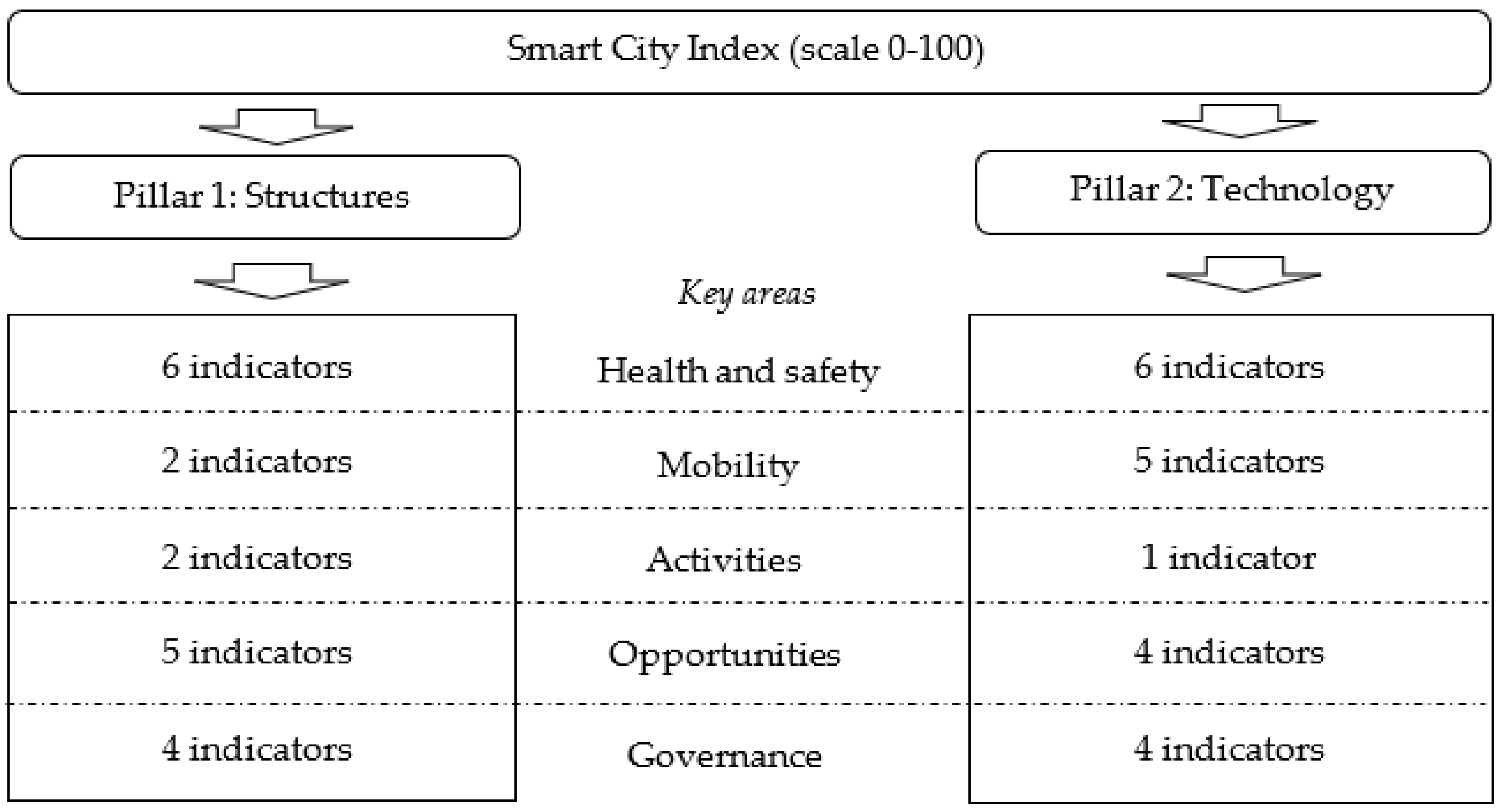
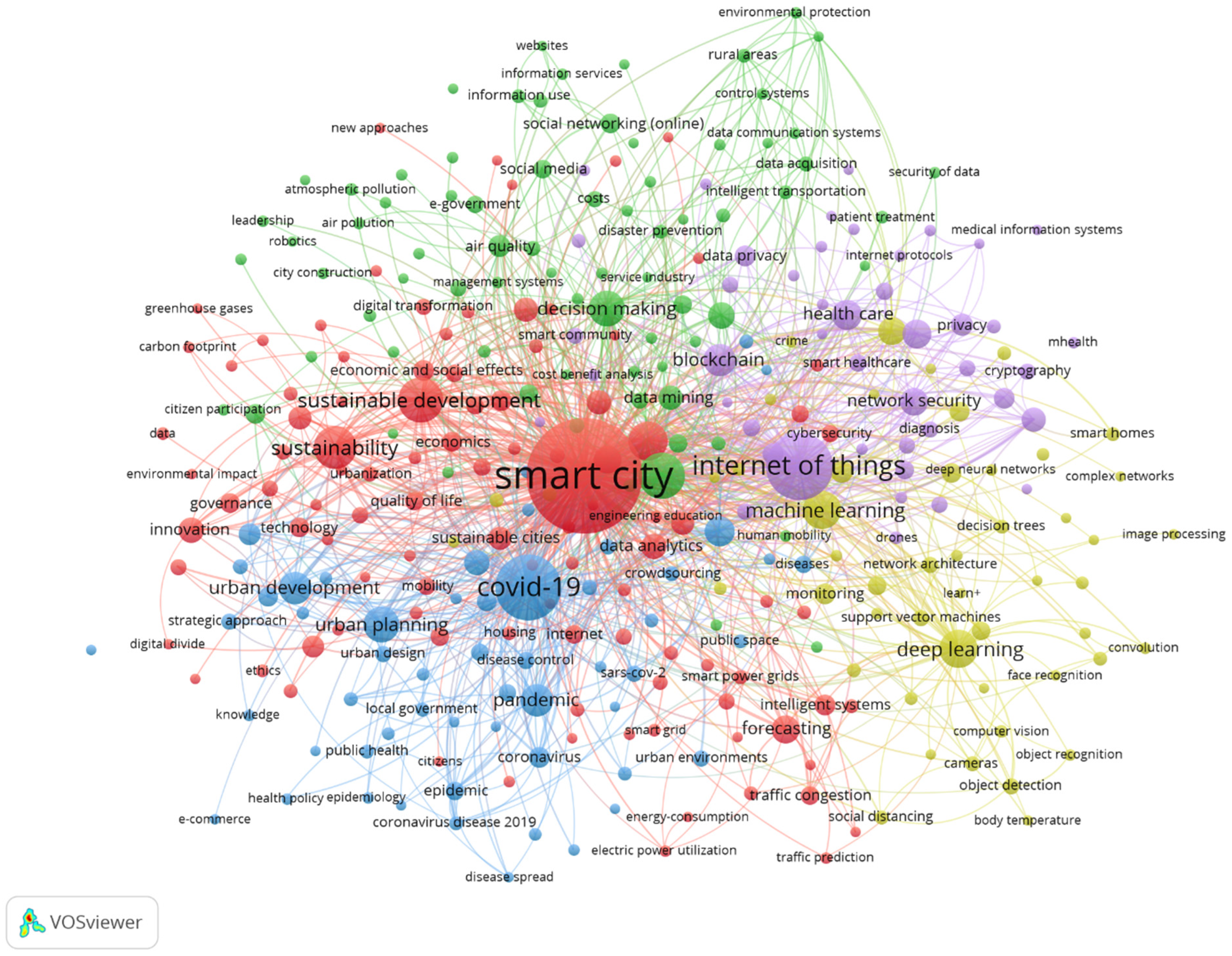
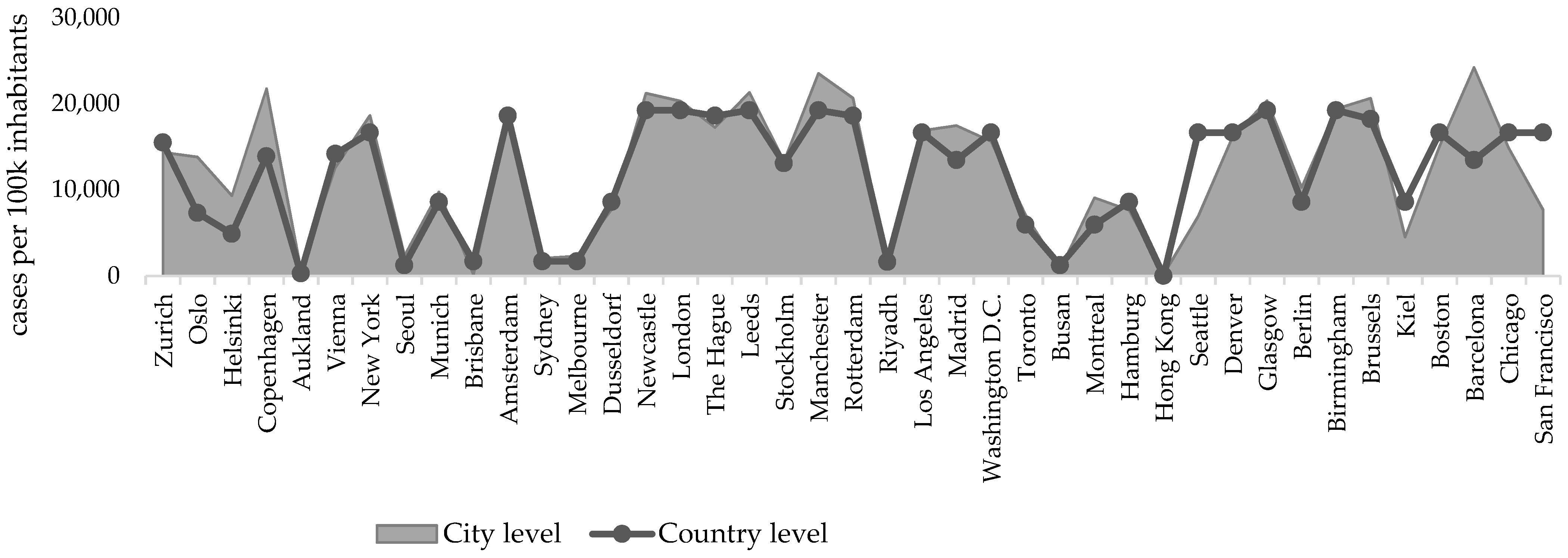
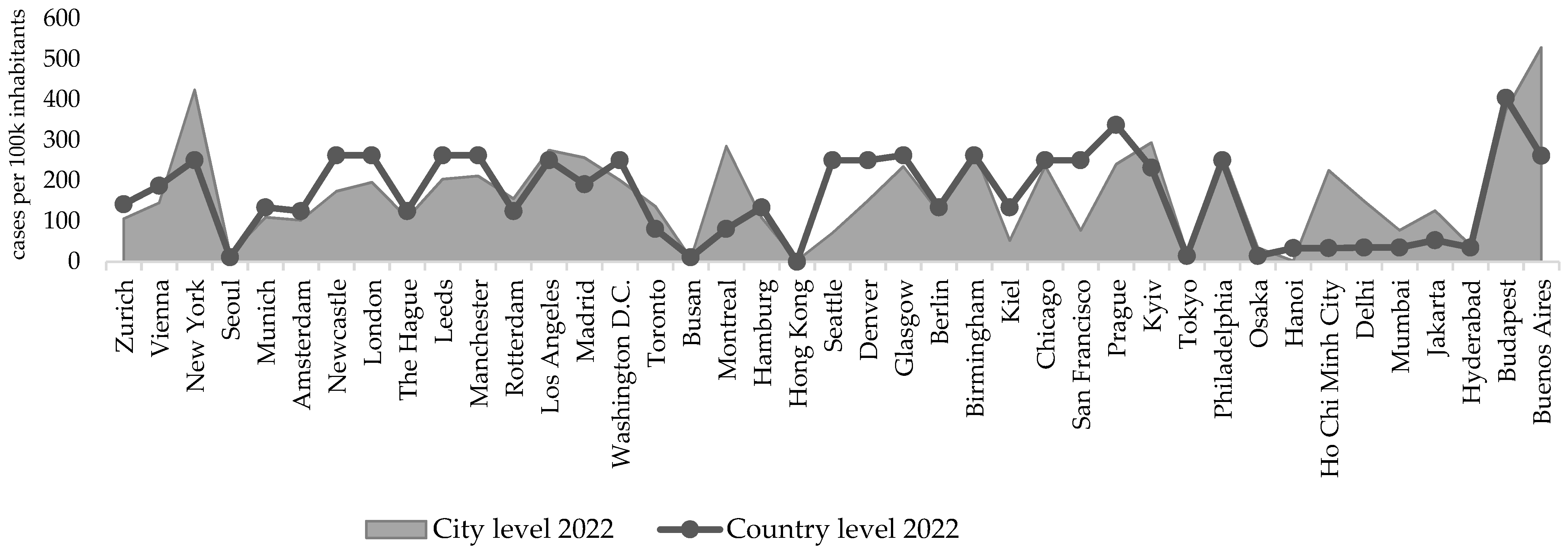
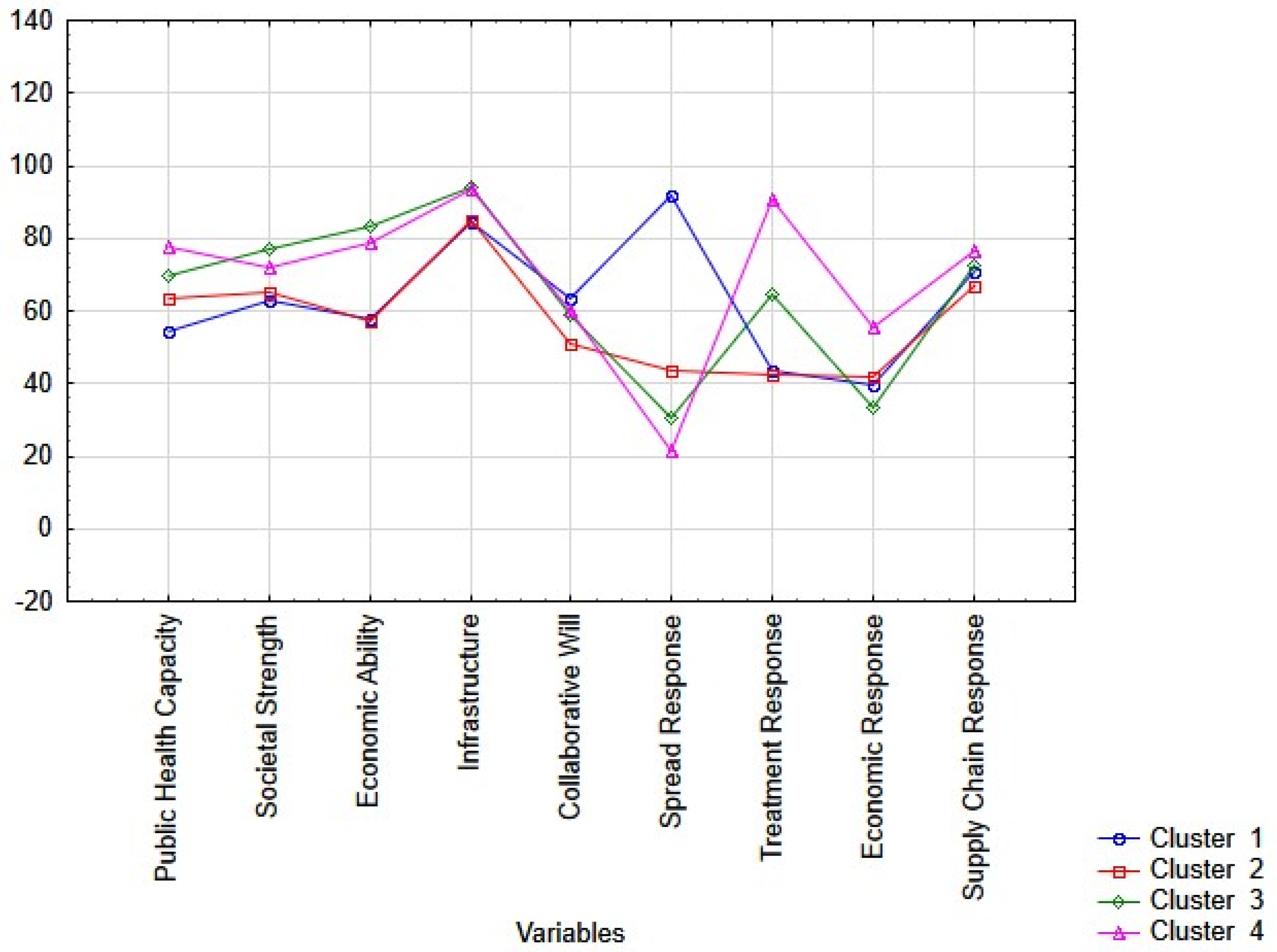
| Rank | Smart City Index 2021 | Smart City Governments 2020/21 | Sustainable Smart Cities 2021 | Sustainable Cities Index 2018 | Quality of Living City Ranking 2019 | Innovation Cities Index 2021 |
|---|---|---|---|---|---|---|
| 1 | Singapore | Singapore | Copenhagen | London | Vienna | Tokyo |
| 2 | Zurich | Seoul | Oslo | Stockholm | Zurich | Boston |
| 3 | Oslo | London | Zurich | Edinburgh | Vancouver | New York |
| 4 | Taipei City | Barcelona | London | Singapore | Munich | Sydney |
| 5 | Lausanne | Helsinki | Stockholm | Vienna | Auckland | Singapore |
| 6 | Helsinki | New York | Singapore | Zurich | Dusseldorf | Dallas-Fort Worth |
| 7 | Copenhagen | Montreal | Amsterdam | Munich | Frankfurt | Seoul |
| 8 | Geneva | Shanghai | Sydney | Oslo | Copenhagen | Houston |
| 9 | Auckland | Vienna | New York | Hong Kong | Geneva | Chicago |
| 10 | Bilbao | Amsterdam | Munich | Frankfurt | Basel | Paris |
| Authors | Title | Year | Source Title | Cited by |
|---|---|---|---|---|
| Allam Z., Jones D.S. [57] | On the coronavirus (COVID-19) outbreak and the smart city network: Universal data sharing standards coupled with artificial intelligence (ai) to benefit urban health monitoring and management | 2020 | Healthcare (Switzerland) | 189 |
| Moreno C., Allam Z., Chabaud D., Gall C., Pratlong F. [58] | Introducing the “15-minute city”: Sustainability, resilience and place identity in future post-pandemic cities | 2021 | Smart Cities | 109 |
| Tan L., Xiao H., Yu K., Aloqaily M., Jararweh Y. [59] | A blockchain-empowered crowdsourcing system for 5G-enabled smart cities | 2021 | Computer Standards and Interfaces | 69 |
| Yigitcanlar T., Butler L., Windle E., Desouza K.C., Mehmood R., Corchado J.M. [60] | Can building “artificially intelligent cities” safeguard humanity from natural disasters, pandemics and other catastrophes? An urban scholar’s perspective | 2020 | Sensors (Switzerland) | 69 |
| Outay F., Mengash H.A., Adnan M. [61] | Applications of unmanned aerial vehicle (UAV) in road safety, traffic and highway infrastructure management: Recent advances and challenges | 2020 | Transportation Research Part A: Policy and Practice | 65 |
| Shorfuzzaman M., Hossain M.S., Alhamid M.F. [62] | Towards the sustainable development of smart cities through mass video surveillance: A response to the COVID-19 pandemic | 2021 | Sustainable Cities and Society | 59 |
| Rahman M.M., Manik M.M.H., Islam M.M., Mahmud S., Kim J.-H. [63] | An automated system to limit COVID-19 using facial mask detection in smart city network | 2020 | IEMTRONICS 2020—International IOT, Electronics and Mechatronics Conference, Proceedings | 58 |
| Allam Z., Jones D.S. [64] | Pandemic stricken cities on lockdown. Where are our planning and design professionals [now, then and into the future]? | 2020 | Land Use Policy | 55 |
| Yigitcanlar T., Cugurullo F. [65] | The sustainability of artificial intelligence: an urbanistic viewpoint from the lens of smart and sustainable cities | 2020 | Sustainability (Switzerland) | 52 |
| Pineda V.S., Corburn J. [66] | Disability, Urban Health Equity, and the Coronavirus Pandemic: Promoting Cities for All | 2020 | Journal of Urban Health | 51 |
| Clusters | Composition of the Cluster (City, Country—SCR *) | Cluster Characteristics |
|---|---|---|
| Cluster 1 (11 cities) | Ankara, Turkey—55, Athens, Greece—111, Bangkok, Thailand—76, Ho Chi Minh City, Vietnam—88, Hong Kong, China—41, Istanbul, Turkey—94, Lagos, Nigeria—115, Makassar, Indonesia—100, Manila, Philippines—102, Medan, Indonesia—99, Vancouver, Canada—33 | No rule for geography No rule for SCR The main criterion is the highest mean for Spread Response |
| Cluster 2 (10 cities) | Bogota, Colombia—116, Budapest, Hungary—97, Buenos Aires, Argentina—98, Jakarta, Indonesia—91, Lisbon, Portugal—95, Medellin, Colombia—101, Mexico City, Mexico—108, Rio de Janeiro, Brazil—118, San Jose, Costa Rica—109, Sao Paulo, Brazil—117 | Predominantly South America Lower-than-average SCR |
| Cluster 3 (12 cities) | Boston, United States—57, Chicago, United States—59, Denver, United States—45, Los Angeles, United States—31, Montreal, Canada—38, New York, United States—12, Philadelphia, United States—85, Phoenix, United States—62, San Francisco, United States—60, Seattle, United States—43, Toronto, Canada—36, Washington, United States—35 | North America Average and higher SCR Average mean for Treatment response |
| Cluster 4 (15 cities) | Brisbane, Australia—16, Busan, South Korea—37, Dusseldorf, Germany—20, Hamburg, Germany—40, Hannover, Germany—47, Hanoi, Vietnam—87, Melbourne, Australia—19, Munich, Germany—14, Osaka, Japan—86, Prague, Czech Republic—78, Rome, Italy—112, Seoul, South Korea—13, Singapore, Singapore—1, Tokyo, Japan—84, Vienna, Austria—11 | Europe + Asia, Australia Predominantly higher-than-average SCR Highest mean for Treatment Response and Economic Response Lowest mean for Spread Response |
| COVID-19 Cities’ Readiness and Responsiveness Indicators | Smart City Rank 2021 Correlation Coef. | t-Value | p-Value | N | Sig. |
|---|---|---|---|---|---|
| Public Health Capacity | −0.4242 | −4.9130 | 0.0000 | 112 | *** |
| Societal Strength | −0.5383 | −6.6983 | 0.0000 | 112 | *** |
| Economic Ability | −0.6460 | −8.8751 | 0.0000 | 112 | *** |
| Infrastructure | −0.6039 | −7.7634 | 0.0000 | 107 | *** |
| Collaborative Will | −0.3374 | −3.7596 | 0.0003 | 112 | *** |
| Spread Response | 0.2284 | 2.1633 | 0.0333 | 87 | ** |
| Treatment Response | −0.4933 | −3.8880 | 0.0003 | 49 | *** |
| Economic Response | −0.3710 | −4.1895 | 0.0001 | 112 | *** |
| Supply Chain Response | −0.3337 | −3.7129 | 0.0003 | 112 | *** |
| Smart City Indicators | 1 January 2021 | 1 January 2022 | ||||||
|---|---|---|---|---|---|---|---|---|
| Coef. | t-Value | p-Value | Sig. | Coef. | t-Value | p-Value | Sig. | |
| Cumulative number of coronavirus cases per 100k inhabitants | ||||||||
| Smart City Rank 2021 | −0.0439 | −0.4149 | 0.6792 | −0.1656 | −1.4540 | 0.1501 | ||
| Basic sanitation meets the needs of the poorest areas | −0.3344 | −3.3474 | 0.0012 | *** | −0.2047 | −1.8113 | 0.0741 | * |
| Medical services provision is satisfactory | −0.2843 | −2.7977 | 0.0063 | *** | −0.1611 | −1.4139 | 0.1615 | |
| Arranging medical appointments online has improved access | −0.3326 | −3.3271 | 0.0013 | *** | −0.3020 | −2.7430 | 0.0076 | *** |
| Cumulative number of coronavirus deaths cases per 100k inhabitants | ||||||||
| Smart City Rank 2021 | −0.0578 | −0.4523 | 0.6527 | 0.1635 | 1.2065 | 0.2330 | ||
| Basic sanitation meets the needs of the poorest areas | −0.5027 | −4.5420 | 0.0000 | *** | −0.5738 | −5.1009 | 0.0000 | *** |
| Medical services provision is satisfactory | −0.5189 | −4.7404 | 0.0000 | *** | −0.6381 | −6.0330 | 0.0000 | *** |
| Arranging medical appointments online has improved access | −0.4040 | −3.4491 | 0.0010 | *** | −0.3950 | −3.1301 | 0.0028 | *** |
| Coronavirus fatality rate | ||||||||
| Smart City Rank 2021 | 0.0976 | 0.7594 | 0.4506 | 0.4574 | 3.7446 | 0.0004 | *** | |
| Basic sanitation meets the needs of the poorest areas | −0.4536 | −3.9430 | 0.0002 | *** | −0.6121 | −5.6355 | 0.0000 | *** |
| Medical services provision is satisfactory | −0.4037 | −3.4184 | 0.0011 | *** | −0.7136 | −7.4158 | 0.0000 | *** |
| Arranging medical appointments online has improved access | −0.2717 | −2.1869 | 0.0327 | ** | −0.4338 | −3.5048 | 0.0009 | *** |
Publisher’s Note: MDPI stays neutral with regard to jurisdictional claims in published maps and institutional affiliations. |
© 2022 by the authors. Licensee MDPI, Basel, Switzerland. This article is an open access article distributed under the terms and conditions of the Creative Commons Attribution (CC BY) license (https://creativecommons.org/licenses/by/4.0/).
Share and Cite
Kuzior, A.; Krawczyk, D.; Brożek, P.; Pakhnenko, O.; Vasylieva, T.; Lyeonov, S. Resilience of Smart Cities to the Consequences of the COVID-19 Pandemic in the Context of Sustainable Development. Sustainability 2022, 14, 12645. https://doi.org/10.3390/su141912645
Kuzior A, Krawczyk D, Brożek P, Pakhnenko O, Vasylieva T, Lyeonov S. Resilience of Smart Cities to the Consequences of the COVID-19 Pandemic in the Context of Sustainable Development. Sustainability. 2022; 14(19):12645. https://doi.org/10.3390/su141912645
Chicago/Turabian StyleKuzior, Aleksandra, Dariusz Krawczyk, Paulina Brożek, Olena Pakhnenko, Tetyana Vasylieva, and Serhiy Lyeonov. 2022. "Resilience of Smart Cities to the Consequences of the COVID-19 Pandemic in the Context of Sustainable Development" Sustainability 14, no. 19: 12645. https://doi.org/10.3390/su141912645
APA StyleKuzior, A., Krawczyk, D., Brożek, P., Pakhnenko, O., Vasylieva, T., & Lyeonov, S. (2022). Resilience of Smart Cities to the Consequences of the COVID-19 Pandemic in the Context of Sustainable Development. Sustainability, 14(19), 12645. https://doi.org/10.3390/su141912645









